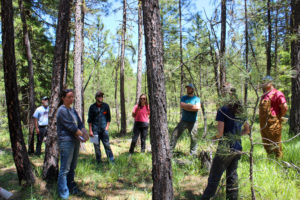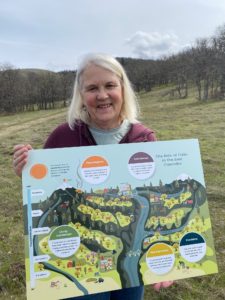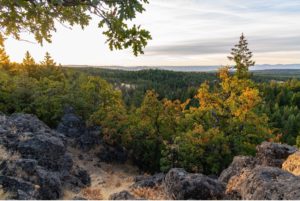The Importance of Oaks
New Funding Will Allow ECOP to Advance Conservation, Stewardship, Outreach, and Monitoring on Oregon White Oak Landscapes
In early August, the East Cascades Oak Partnership (ECOP) was awarded a $7.1 million grant from the Oregon Watershed Enhancement Board (OWEB), as one of five new awardees supporting healthy watersheds across the state.
ECOP works on the east slopes of the Cascades, where the Oregon white oak (Quercus garryana) can be found in a variety of settings, from a lone, massive tree in a native bunchgrass savanna to thousands of oaks huddled together on an exposed slope, dwarfed by strong winds. Among many benefits, Oaks provide shade in harsh environments, support first foods important to Indigenous peoples, provide a scenic backdrop for hiking and mountain biking trails, can function as a buffer against catastrophic wildlife, and support hundreds of species of wildlife with their acorn crops, fungal and plant associations, and abundant cavities.
In the East Cascades, biodiversity and climate resilience are threatened by fire suppression, development, overgrazing, and passive management, but ECOP is working to change that. Columbia Land Trust is the fiscal and administrative sponsor of the six-year old partnership, which grew from an initial $10,000 exploratory grant from Pacific Birds into a robust group of more than 25 tribal, public, and private entities collaborating to restore fire-adapted conditions, protect biodiversity, and maintain climate resilience.
“This funding will facilitate a landscape level monitoring approach to the geographically unique Oregon white oak plant community east of the Cascades, while also connecting a network of partners who manage and enhance oak plant communities on public, state, and private lands,” said Whitney Olsker and Christina Mead, respectively a silviculturist and botanist with the Mt. Hood National Forest.
 The wide-ranging partners work together to leverage resources, share knowledge, and implement conservation strategies that will protect vulnerable oak habitats and encourage more sustainable human interactions with these important resources that vital to ecosystems and economies.
The wide-ranging partners work together to leverage resources, share knowledge, and implement conservation strategies that will protect vulnerable oak habitats and encourage more sustainable human interactions with these important resources that vital to ecosystems and economies.
“ECOP looks at conservation through the lens of human interaction,” said Partnership Manager Lindsay Cornelius. “People have a variety of needs and interests across oak landscapes and there are different ways of approaching conservation that can leverage positive outcomes for humans and nature.”
Climate modeling completed by The Nature Conservancy predicts that portions of the East Cascades with a high diversity of soil types, microclimates, and low levels of development will have higher resilience to climate change. Protecting and restoring connected landscapes to ensure plants and wildlife have the space and opportunity to adapt is central to the vision and work of both ECOP and Columbia Land Trust.
“In a time of changing climate, this [initiative] is well suited to support biodiversity in oak woodland and prairie habitats, and help protect vulnerable communities from catastrophic wildfire,” said OWEB Executive Director Lisa Charpilloz Hason. “The partnership will engage a broad diversity of people, and OWEB is excited to join them as a funding partner over the next six years. OWEB is committed to investing in conservation that helps communities mitigate and adapt to the impacts of climate change.”
 With this infusion of funding, ECOP will be able to protect 15,000 acres of habitat from conversion, reverse the effects of fire suppression on 17,000 acres, strategically deploy outreach to engage private landowners, lower barriers to the use of prescribed fire, expand access to native plant materials, and implement new monitoring and assessment tools. The funds will also enable the partnership to hire additional staff and create new tools, like a website to help land managers determine the historic condition of specific sites to inform future management.
With this infusion of funding, ECOP will be able to protect 15,000 acres of habitat from conversion, reverse the effects of fire suppression on 17,000 acres, strategically deploy outreach to engage private landowners, lower barriers to the use of prescribed fire, expand access to native plant materials, and implement new monitoring and assessment tools. The funds will also enable the partnership to hire additional staff and create new tools, like a website to help land managers determine the historic condition of specific sites to inform future management.
“In a short time, the East Cascades Oak Partnership has made leaps and bounds in increasing awareness around oak ecosystems and their important functions,” said Chase Brown, Oregon Department of Fish and Wildlife White River Wildlife Area Manager. “These recently awarded funds will enable us to implement on-the-ground landscape scale restoration projects. The Oregon Department of Fish and Wildlife is extremely excited to be a part of this partnership and will use the funding to create healthier, more fire resilient ecosystems.”
“This is an important moment for ECOP,” said Cornelius. “We are overcoming misperceptions that oaks east of the Cascades are not important for conservation because they are smaller in stature and are locally abundant, when in fact they are critically important for migratory and resident birds, pollinators, and wildlife precisely because these oak habitats are still meaningfully connected. This OWEB investment, along with the award to the Klamath Siskiyou Oak Network, signals an important shift that oak landscapes are finally getting conservation attention at the state level. “Working together with the people who live in these landscapes, helping them see the value and vitality of these important plants and animals, and understanding the reciprocal relationship between nature and people—that is our privilege and our responsibility. We are ready.”
Partners that will directly support project implementation include Oregon Department of Fish & Wildlife, Oregon State Parks, USFS – Mt. Hood National Forest and Columbia River Gorge National Scenic Area, Confederated Tribes of the Warm Springs, Columbia Land Trust, Oregon Department of Forestry, and the Natural Resource Conservation Service.
